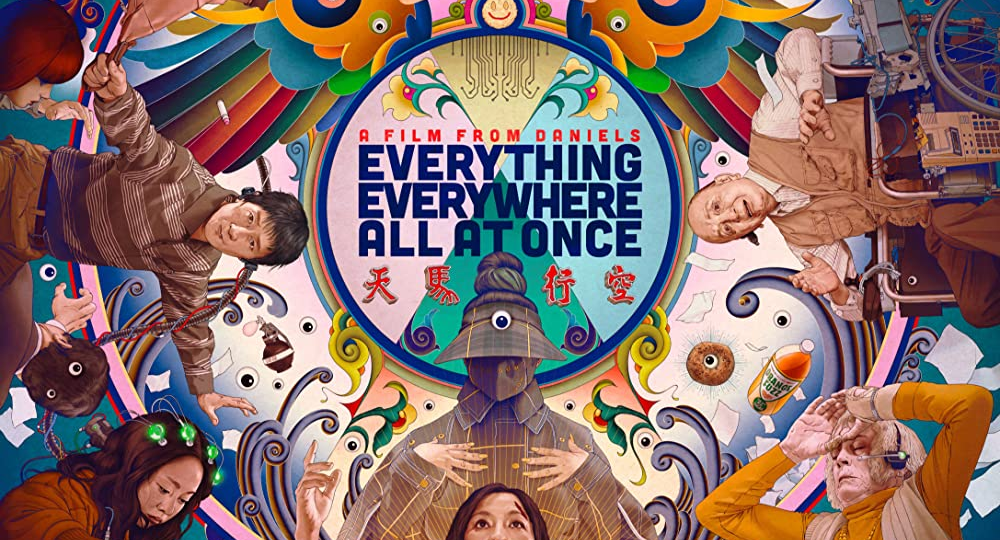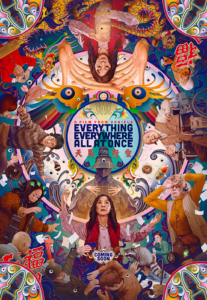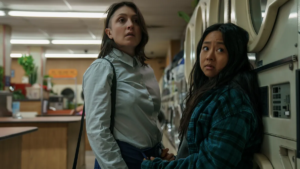
“Everything Everywhere All At Once”: The Success of Diverse Storytelling and Experimental Cinema
The maximalist masterpiece, “Everything Everywhere All At Once,” is a conglomeration of many different multiverses following middle-aged, Chinese-immigrant, Evelyn Wang. With 377 nominations and 354 wins according to IMBD, this film impacted the box office with its intense genre experimentation, amazing in-depth plot, and well-rounded character development. This film speaks on multiple themes surrounding family and uses ‘out of this world’ visuals to successfully communicate that with the audience.

Source: https://m.imdb.com/title/tt6710474/
“Everything Everywhere All At Once” is a two hour nineteen minute film directed and written by Daniel Kwan and Daniel Scheinert. It follows a Chinese mother named Evelyn Wang (Michelle Yeoh) as she goes through a stressful day, caring for her father, managing the family laundromat, and filing her taxes.
At an IRS building, Evelyn’s life starts to turn upside down when another version of her husband, Waymond (Ke Huy Quan), warns her of a great multiverse-ending danger by a creature called Jobu Tupaki (Stephanie Hsu). Evelyn starts to question the relationship between her and her family and the meaning of her life as she continues to jump through her multiverse personas. These characters are experiencing very real themes, like generational trauma and acceptance while also dealing with fantastical subjects, like multiversal jumping and chaotic multiverse-hopping beings.

Source: https://collider.com/stephanie-hsu-everything-everywhere-all-at-once/
There are a lot of aspects of this film that break general Hollywood tropes. Notably, the protagonist is a middle-aged immigrant and highlights the usage of LGBTQ+ characters. Because the film avoids cliches, we can see into stories of minorities without Hollywood biases directing harmful stereotypes.
Seeing the casual life of an immigrant mother with a gay daughter, and seeing the possibilities of her life with different choices is unique in Hollywood. It told us a different story than the ones we are used to in mainstream media.
This film also impacted the actors as much as it did the characters. Ke Huy Quan’s acting career was dead after his involvement in the popular 80’s films “Indiana Jones” (1984) and “Goonies” (1985). “Everything Everywhere All At Once” was that chance that Quan needed to refresh his career with 70 awards for the film from various associations. Michelle Yeoh was also extremely successful with this film. According to the Motion Picture Association, she made history as the first Asian woman to win Best Actress in many associations like the Golden Globes and the Oscars.
This success told us that people want to see more movies with diverse representation.

Source: https://www.maxon.net/en/article/behind-the-scenes-of-everything-everywhere-all-at-once
This unique film explores many different genre tropes to highlight the chaos of the movie. It explores sci-fi with the multiverse ‘jumping’, comedy with scenes involving parody or irony and classic kung-fu fighting with traditional eastern Asian fight scenes. Co-directors Kwan and Scheinert said the genre-mashing was “emblematic of the pandemonium of modern life”.
The directors also experimented with maximalist cinema, which is seen in many of the scenes throughout the film. There is no break between the onslaught of information and the erratic movements that the actors perform. There is a sense of absurdity that follows this cinematic style – everything is done for a reason.
Scenes are slightly overstimulating with the loud costumes and erratic movements, but when things start to slow down we notice purposeful interactions and development between characters. It’s not to say that the idea of reflecting the chaos of life with stunning visuals isn’t successful, but it’s easier to understand character development through more mundane communications.

Source: https://www.latimes.com/entertainment-arts/movies/story/2022-04-14/everything-everywhere-all-at-once-explained-daniels-spoilers
A prevailing topic throughout the film is generational trauma, especially with immigrant parents. Evelyn struggles with pleasing her father, which can be seen in how she interacts with him in her flashbacks of life in China and her current life in America.
These actions transfer over to how she treats her daughter, Joy (Stephanie Hsu), throughout her life. Evelyn insults, diminishes and is unfortunately unsupportive throughout the beginning of the movie. She treats her husband the same way, berating his kindness and acts of service instead of being supportive.
Evelyn’s entire character development revolves around this contemplation and acceptance of her family. Director Kwan said, “It’s about a mom learning to pay attention to her family in the chaos,” The clear character development that Evelyn receives throughout the film is especially demonstrated by contrasting how she acts around Joy’s girlfriend, Becky.
In the beginning, Evelyn misgenders Becky, using he/him pronouns when she identifies as a woman. Evelyn justifies this stating she grew up differently, then by the end of the film she notices that what she says to her daughter matters and comes to accept her and her relationship. We as the viewer were growing with Evelyn as a character as she learns to accept her daughter and mend her relationship with her husband.

Source: https://www.usatoday.com/story/entertainment/movies/2022/04/12/everything-everywhere-all-at-once-queer-acceptance/7281672001/
I first saw “Everything Everywhere All At Once” in theaters when it came out in March of 2022, and I realized one thing; I needed to rewatch this movie. I tend to collect physical copies of films and this was on my to-buy list as soon as I left the theater.
I knew I was going to watch it many more times after that experience and since then I’ve seen it three more times. The detail that was put into the multiverse aspect was brilliant, and the bizarre scenarios that I watched made me laugh silly. In my opinion, the way the Daniel’s approached sensitive topics, like depression, neurodivergence, and Asian American identities, allowed the viewer to understand those themes and the characters’ part in them, without making the film boring or too hard to understand.
There is a sense of casualness with the delivery of the lines and the absurdity of many scenes that I appreciated because, without it, this would’ve been a completely different and potentially less successful film.

Source: https://www.vogue.com.au/culture/features/everything-everywhere-all-at-once/news-story/865422c8f0a443ed72be1dfccd4051c5
“Everything Everywhere All At Once” is currently the most-awarded film of all time, according to IGN, but that’s not without reason. There is so much niche detail that it takes a couple of watch-throughs to comprehend everything that the Daniel’s are telling; even then there is something new in each rewatch. This film couldn’t stick to one genre, spoke on minority stories, and was one of the most absurd films I’ve ever seen, but it made history and was an amazing story from 2022.
“Everything Everywhere All At Once” is able to be viewed through various premium subscription services like Paramount+ and Hulu.

